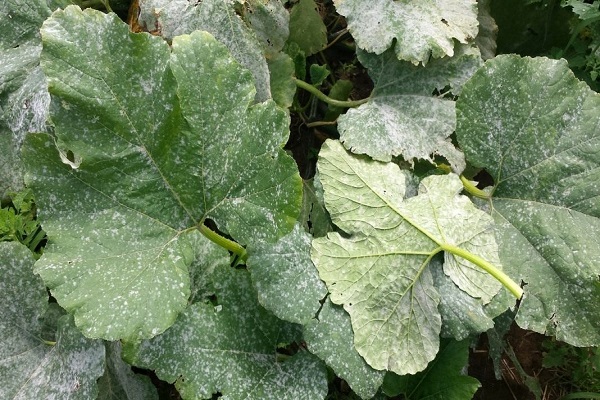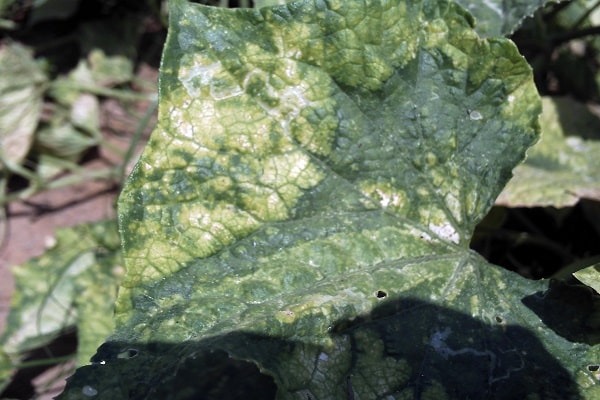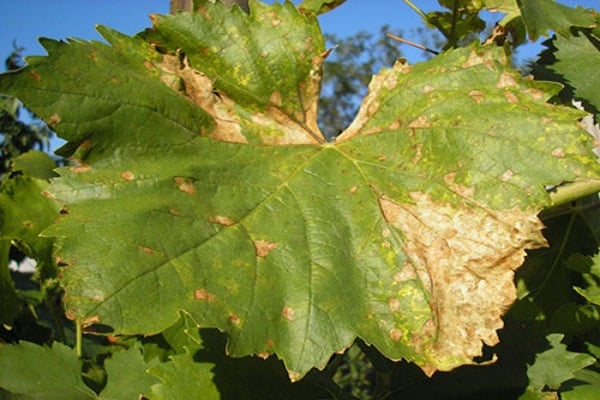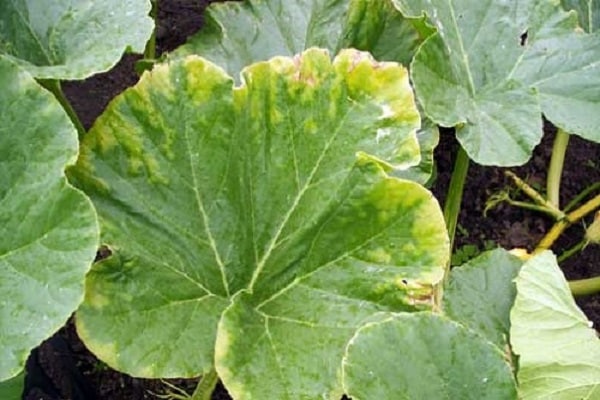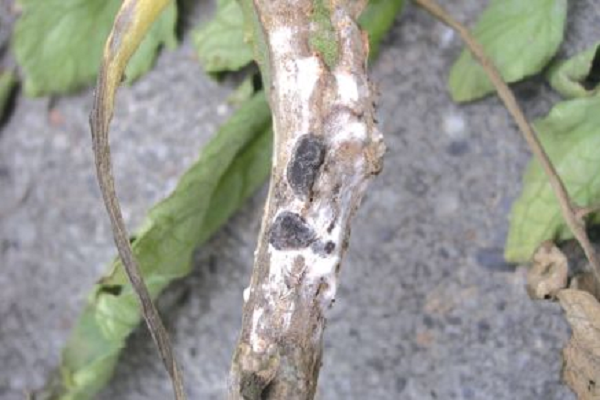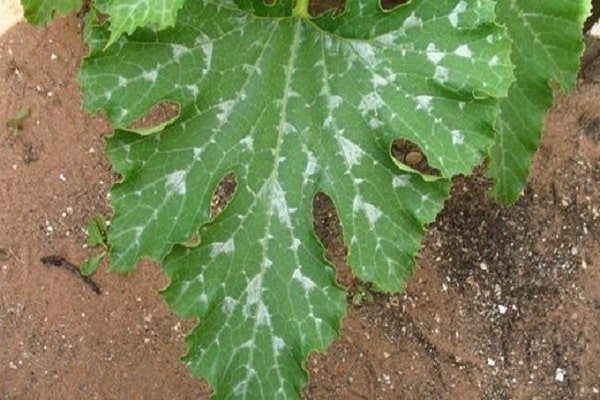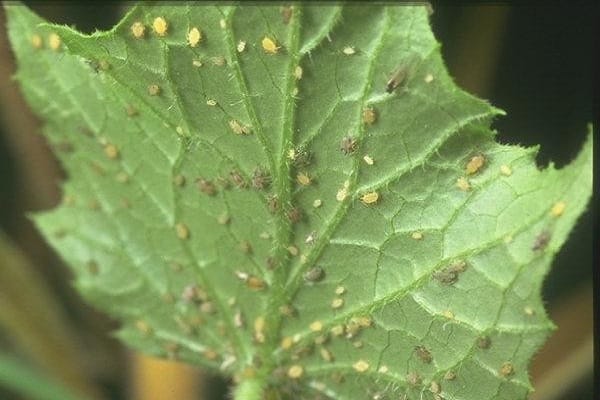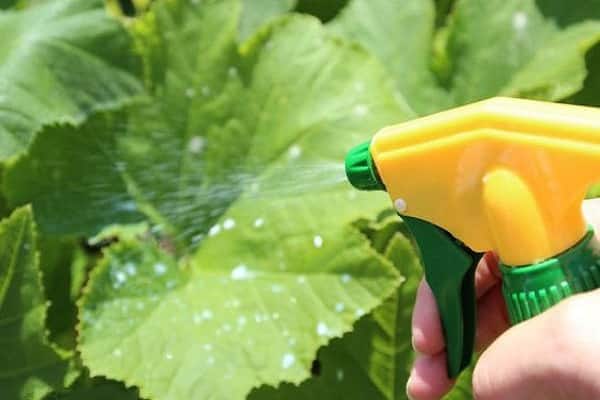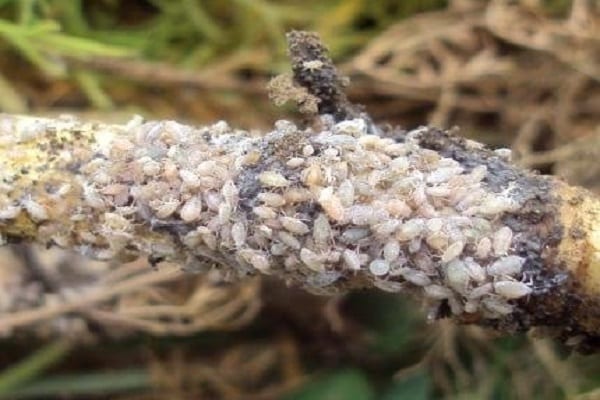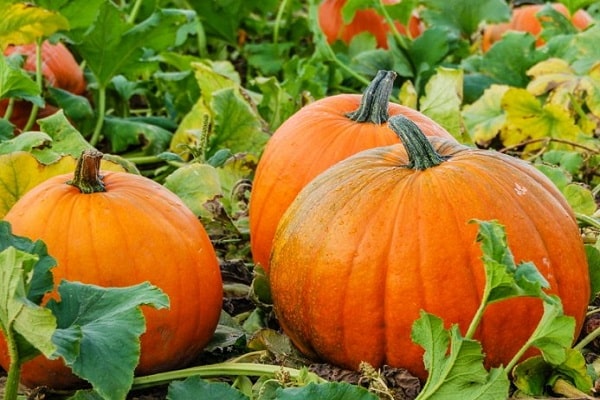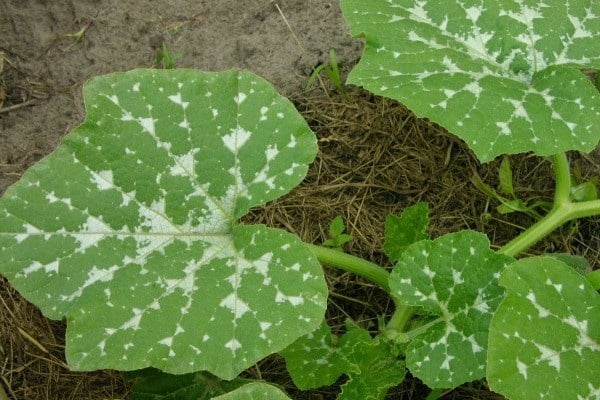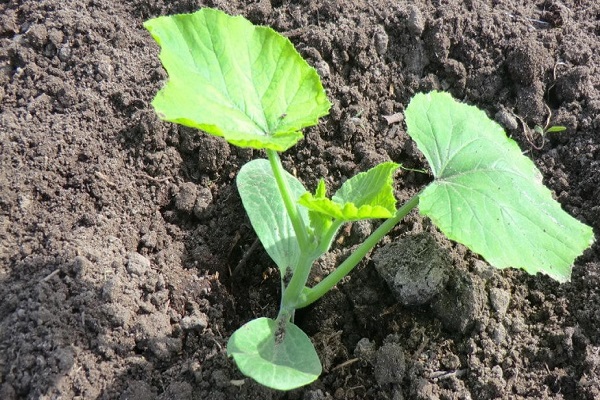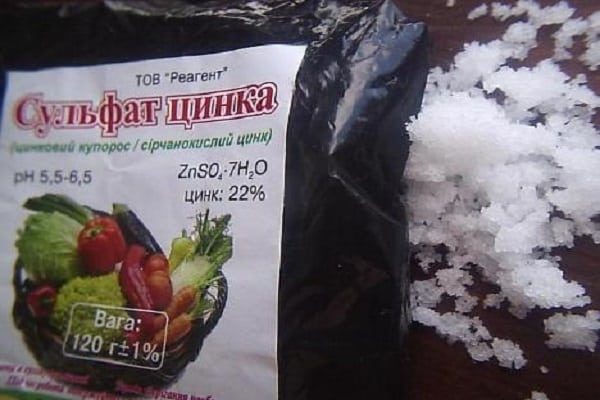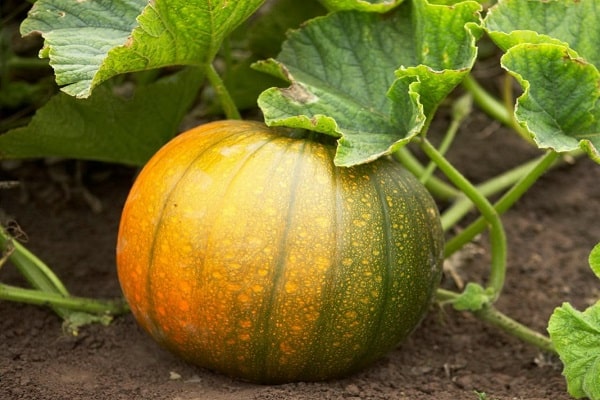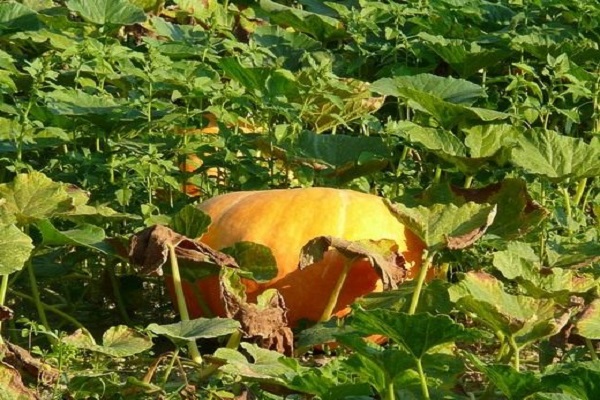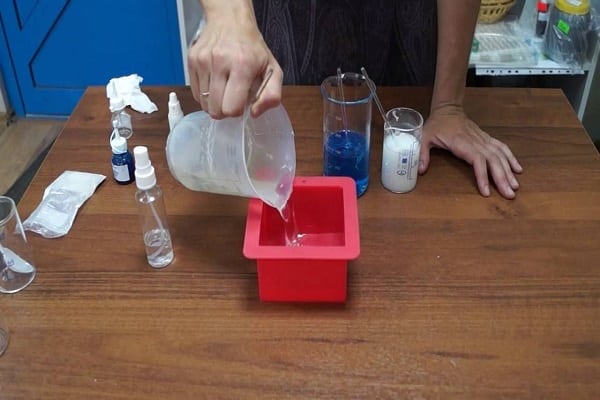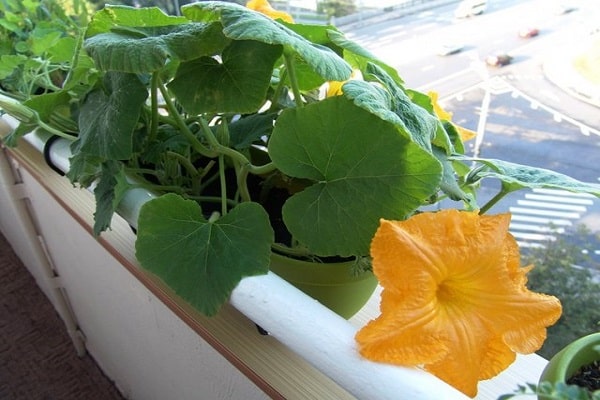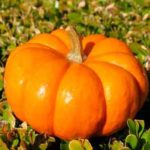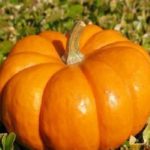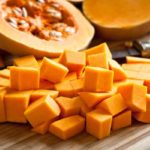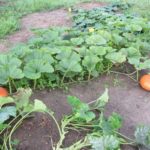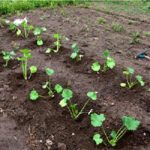It is useful to know how to protect pumpkins in open ground from diseases and pests. The culture has good immunity, but in the presence of negative factors it suffers from infections and pests. Identifying the disease at an early stage and proper treatment can save the plant and crop from death.
Powdery mildew
Poor agricultural practices are the main cause of powdery mildew on pumpkins. Damp, cool weather accelerates its development. Powdery mildew is a fungal disease spread by spores. Weeds and plant debris in the garden become breeding grounds for infection.Excess nitrogen in the soil and infrequent watering provoke the onset of the disease.
You can find out about the onset of the disease by the symptoms - a small round white spot on the leaves. As the disease progresses, a white coating appears on the petioles and stems. The affected areas of the plant turn brown and dry out. In a diseased plant, the process of photosynthesis is disrupted, which slows down the formation of ovaries (fruits) and deteriorates their quality (taste, shape).
Control measures for powdery mildew of pumpkin:
- removal and destruction of fungus-affected areas of the plant;
- treatment of bushes with a solution of colloidal sulfur - 20 g per 10 l;
- spraying with sodium phosphate - 50 g per 10 l;
- mullein is infused for 3 days (1:3) and the bushes are treated with a solution prepared from 3 liters of water and 1 liter of mullein infusion;
- in exceptional cases, they resort to chemistry - they treat pumpkin bushes with Topaz.
You can choose modern pumpkin varieties for planting that are resistant to powdery mildew.
Downy mildew or downy mildew
A disease that resembles powdery mildew in appearance. The difference is in the shade of the plaque; if with powdery mildew it is grayish, then with peronosporosis the spots have a purple tint and it is located on the back side of the leaf. Yellow spots are visible on the front side of the leaf plate, which quickly darken and dry.
The intensive course of the disease is observed at high air humidity and moderate temperature (17–22 °C). Dew and fog intensify the symptoms of the disease in plants; their treatment comes down to more than just spraying the pumpkin bushes with copper oxychloride. It is imperative to cultivate the soil around diseased bushes. For 10 liters of water you need 40 g of the drug. One liter of solution is enough to treat 10 m² of soil.
Anthracnose
You can tell that your pumpkin has anthracnose when signs of the disease appear—yellow-brown spots on the leaves. They have a round shape and gradually change color, acquiring a pink tint. The most unpleasant thing about this disease is the unsuitability of the fruit for consumption. The taste of the pulp takes on a bitter aftertaste.
With severe infection, the disease affects the root system and leads to the death of the plant. This pumpkin disease occurs due to a fungus; the fight against it includes a set of measures:
- treatment of seeds before sowing with infusion of ash (20 g per 1 liter of water), they are soaked for 5 hours;
- crop rotation;
- treating the soil with a fungicide before planting;
- in autumn, remove all plant debris.
Bacteriosis
Bacteriosis of all pumpkin diseases causes the greatest damage; the symptoms of the disease are: infection of the leaves - angular brown spots and brown ulcers on the cotyledons. Ulcers also appear on the bark of the fruits, causing them to become ugly.
Pumpkin seeds are affected by bacteriosis and become sources of infection.
The root system and stems suffer. Holes appear in places where there were stains. Bacteriosis is treated with a white liquid obtained by mixing lime (10 g) and copper sulfate (10 g) in water. This mixture should be used to treat the diseased pumpkin bush when the first symptoms appear. It is better to destroy plants affected by the disease. This is recommended by experienced gardeners.
White rot or sclerotinia
A common disease that affects pumpkins in open ground during fruiting is white rot (sclerotinia). The marsupial fungus attacks fruits and other parts of the plant; its spores overwinter in the soil, are carried by the wind, and are activated by increased soil and air humidity.
A white coating first appears on the surface of infected fruits; under the influence of infection, the pulp and skin of the fruits soften and they lose their nutritional value. Treatment consists of removing leaves and fruits affected by the fungus. During an outbreak of infection, the pumpkin is sprayed with copper sulfate (5%). To prevent white rot, bushes are sprayed with a urea solution (10 g per 10 liters of water) and watered only with warm water.
How to fight aphids on pumpkin?
Aphids weaken young plants as they reproduce intensively in a short time. On pumpkins, aphids form entire colonies, settling on the back of the leaves. The melon aphid is clearly visible to the naked eye. Curled leaves on a pumpkin are one of the signs of aphids. These small insects suck out the juice and spoil not only the leaves, but also the buds and already formed ovaries.
Adult insects are carriers of many diseases. Weakened plants are stunted in growth, with severe infection they die, and the fruits do not ripen. Gardeners fight aphids using traditional methods. Use:
- onion peel;
- wormwood and celandine;
- laundry soap.
To prepare onion infusion, take 200 g of onion peel, pour it into 10 liters of hot water, and infuse it. Before use, add grated laundry soap.
Wormwood and celandine are infused in a similar way. Take 2 kg of crushed raw materials, fill it with a bucket of hot water, let it sit for a day, add a soap solution and spray the pumpkin leaves on all sides. After a few days, the treatment is repeated.
In severe cases, they resort to chemistry. Use:
- Actellik.
- Triphos.
- Karbofos.
Disease Prevention
The main diseases of pumpkin are caused by fungi that overwinter in the soil or persist on plant debris. Weakened plants are especially susceptible to disease.List of causes causing diseases:
- planting seeds infected with spores of the pathogenic fungus;
- densely planted plants;
- frequent, abundant watering, increased humidity in the root zone;
- lack of crop rotation, accumulation of infection in the soil;
- presence of weeds in the garden;
- overdose of nitrogen fertilizers.
To prevent diseases of melons and melons, there is a set of agrotechnical measures that has been proven over the years. First of all, crop rotation. Proper planting planning involves returning the pumpkin crop to its original location no more than once every 3–4 years.
Cleanliness of the site: absence of weeds during the growing season, complete removal of all plant residues in the fall after harvesting. Burning diseased plants. Autumn digging of the soil with the obligatory application of organic matter (manure, humus, compost).
The right choice of neighbors. Do not plant melons, watermelons and zucchini next to pumpkins. Find more useful neighbors: corn, beans. Following recommended planting patterns plays a big role in the health of pumpkins. Dense planting leads to excessive moisture in the root zone and provokes the proliferation of fungus.
Pre-sowing treatment of seed material is the main preventive measure. By planting seeds infected with fungus, you are guaranteed to lose your harvest and infect the soil and other crops that are sensitive to this type of infection. There are special preparations for treating pumpkin seeds:
- Potassium permanganate.
- Fentiuram.
- Zinc sulfate 0.02%.
Fertilizing is the basis for the health of any plant.It is thanks to root and foliar application of fertilizers (organic, mineral) that gardeners provide plants with the necessary set of nutrients, which allows them to cope with infections of any kind.
Disease Control
It should not be ruled out that in the summer you will notice symptoms of a particular disease or pest on your plants. You can accurately determine the name of a pumpkin disease in open ground from a photo with its signs. All that remains is to choose the right method of combating it - with what and how to treat the soil and the diseased bush.
| Disease | Treatment |
| Powdery mildew | Remove all leaves that show even the slightest signs of disease, prepare a solution of colloidal sulfur - dissolve 20 g of the drug in a bucket and spray the diseased bush. |
| Downy mildew | Remove the affected areas of the bush, for treatment you need to have copper oxychloride, prepare the solution using warm water (10 l), adding 40 g of the drug to it, recommended consumption is 1 liter per 10 m², treat the soil and plants. |
| Anthracosis | First of all, remove all diseased leaves, stems, fruits, prepare a 1% solution of Bordeaux mixture or a 90% solution of copper oxychloride and treat all bushes, even healthy ones. |
| White rot or sclerotinia | The disease progresses in hot, dry weather; after removing the diseased leaves, the broken areas must be sprinkled with crushed charcoal; instead, the damaged areas can be treated with copper sulfate, solution concentration 0.5%. |
| Bacteriosis | It is best to remove the diseased plant along with the roots and destroy it, and treat the soil and bushes growing nearby with a solution prepared from a mixture of copper sulfate and lime, add 10 g of each product to a bucket of water. |
Pumpkin suffers not only from diseases, but also from pests. You need to be able to help the plant in a timely manner; a large number of pests lead to the death of the plant, especially in the early stages of their development. Traditional methods of control are considered safe for fruits; they are effective in the early stages of infection.
To combat aphids and spider mites, you need to have an infusion of onion peels; you can spray the bushes for prevention in the first days after infection. The infusion is easy to prepare: pour 200 g of dry husk with 10 liters of water and leave for several days. Spraying bushes with onion peels is especially effective in hot, dry weather.
Regular soapy water helps against aphids. To a bucket of water you need to add one 200-gram piece of laundry soap (shaved with a knife or grated on a coarse grater). If there is massive damage to bushes, you have to resort to chemicals. You can use Karbofos. The solution is prepared from water (10 l) and Karbofos (60 g).
One conclusion can be drawn. If you want to eat healthy pumpkin fruits without using chemicals when growing them, do not neglect preventive measures:
- treat the seed before planting;
- do not forget about the annual autumn tillage of the soil, which consists not only of removing debris, it also involves the application of organic and mineral fertilizers;
- feed the pumpkin with complex mineral fertilizers during the season;
- destroy weeds.
Using these simple tips, you will always have a good harvest of healthy fruits that will be well stored even in a city apartment.

